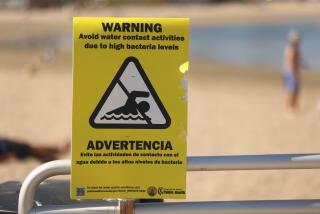Study Finds Coast Waters Healthier
In perhaps the largest environmental survey ever conducted along the Southern California coast, researchers have found improving conditions in fish and other marine life, with some contaminant levels dropping a dramatic 95% from two decades ago, federal and state officials said Wednesday.
But the study released by the U.S. Environmental Protection Agency, which worked on the project with 11 other agencies, also made some discouraging discoveries, such as contaminants in 89% of the mud and sand offshore. The pesticide DDT was the most widespread contaminant in sediments, with the highest concentrations off the Palos Verdes shelf, the study found.
âItâs definitely more good news than bad news,â said Randy Wittorp, spokesman at the EPA regional office in San Francisco.
âThe good news is that the overall health of the offshore waters has improved significantly compared to 20 years ago. It shows weâre doing the right thing and moving in the right direction,â he said.
âThe bad news is that thereâs still significant pollution out there, and we have to do more.â
The study provides a snapshot of environmental conditions in 1994, when sampling was done at 261 sites. Nearly 20 million people live in the broad area along the Southern California coast and offshore waters, making it one of the most densely populated coastlines in the United States, the study notes.
Researchers examined the condition of the areaâs waters, fish and sediment, and even the types of debris collected in nets towed along the ocean floor.
Among their conclusions:
* Populations of bottom-dwelling fish were generally healthier in 1994, with external fish diseases such as fin erosion--prevalent in some areas in the 1970s--virtually absent in 1994 fish samples.
* DDT and PCB contamination remained widespread in fish.
Even so, âdramatic declines in fish liver DDT and PCB concentrations have occurred throughoutâ the coastal waters from Point Conception to the Mexican border, the report states. âBoth DDT and PCB concentrations in fish from reference areas are now less than 5% of levels measured during the last two decades.â
* Low levels of contamination in mud and sand remain a major concern, with DDT found in 82% of the substances. Most of that DDT is from old discharges of the pesticide, which was banned in 1972, experts said.
âThe extent and magnitude of sediment contamination was greater in Santa Monica Bay than in other regionsâ of the study area. âAll of the Santa Monica Bay sediments were contaminated by at least one chemical.â
* Water quality was described as good, with 99% of it meeting objectives for clarity and oxygen content.
Monitoring for the study cost an estimated $10 million. Participants included the State Water Resources Control Board and Southern Californiaâs four largest sanitation agencies, as well as the Santa Monica Bay Restoration Project. Also involved was the Southern California Coastal Water Research Project, a public agency that coordinated the work.
âThis study is the first time that weâve been given the big picture of the overall health of the Southern California coast,â Wittorp said. âItâs a good example of how a variety of agencies were able to work together to gather information based on good science.â
Nancy Wheatley, director of technical services for the Orange County Sanitation Districts, said the study found that âtoxics like pesticides and other chemicals have shown considerable decreases.â
More to Read
Sign up for Essential California
The most important California stories and recommendations in your inbox every morning.
You may occasionally receive promotional content from the Los Angeles Times.










